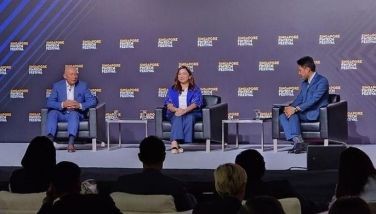Spurring GSM growth
The countdown to the 2009 Mobile World Congress (formerly 3GSM World Congress) held annually in Barcelona, Spain has begun.
Despite the gloomy economic outlook worldwide, the red carpet has been rolled out — drum rolls and all — for the world’s largest exhibition for the mobile industry, which this year expects to draw around 50,000 attendees on Feb. 16-19.
This year, the fourth to be held in Barcelona after a number of years in Cannes, France, congress participants as usual expect a vibrant discussion space for the hottest trends in the telecommunications industry — mobile innovations and applications, mobile ecosystems and enterprises, new devices and technology evolution, mobile advertising and entertainment and even the so-called M-government. It is going to be — as in years past — a geek heartland.
In his first press interview in the Philippines, Craig Ehrlich, immediate past chairman of the GSM Association (GSMA) that hosts the annual convention, sat down with The STAR to discuss the global telecommunications space and the organization credited for having steered the directions of the industry in the last decade.
The GSMA is global trade association representing the interests of over 750 GSM mobile phone operators and over 200 manufacturers and suppliers worldwide.
Phenomenal growth
According to Ehrlich, the growth of mobile phone usage worldwide in the last seven years that he was chairman of the GSMA was phenomenal, yet there is still room for growth. In the last three years, mobile phone subscribers are growing by approximately a million a day.
Handset sales have declined or is projected to decline by 10 to 12 percent, he said, but new subscribers are still growing to around a billion a year and this growth could be sustained.
“Almost half of the growth is recorded in only two countries — India and China,” he disclosed. “Both countries record 160 million to 350 million new users per year.”
“When I became chairman in 2002, the mobile telecom industry was vastly different from the environment we are living in today,” he said in his farewell speech.
Back then, he said a mere 500 million subscribers were using mobile devices, compared to the 3.5-billion mobile (GSM) subscribers the world now has, most of whom enjoy rich and varied services that span their home and business lives.
“We’ve worked to promote a mobile technology as a tool to enhance people’s lives, and we’ve seen the impact mobile has had around the world,” he added.
Emerging markets
Ehrlich underscored the importance of the so-called emerging markets in the global adoption of mobile technology.
“During my time as chairman, we made a commitment to the emerging markets. Our commitment to these regions meant that consumers had access to low-cost 2G handsets which was instrumental in spurring growth,” he said.
Five to six years ago, Ehrlich cited that the cost of the lowest-priced mobile phones was around $60 to $70 (P3,000 to P4,000). Within six months, GSM worked with phone manufactures to be able to offer it to under $40 (P2,000). In the next few years, the price was reduced further to $30 (P1,500) and finally to under $20 (P1,000).
This program, he said, has been replicated in driving down the cost of 3G handsets down to under $200 (P8,000 to P10,000).
“The goal is to support the growth of the market for mobile products and services,” he said.
Though the GSMA has continuously worked on various programs and initiatives to support the growth of mobile phone usage and bring the cost of the equipment down, Ehrlich clarified that they were never involved in price fixing for subscription cost and in that area allow market forces to determine prices.
“On the policy level, we are being watched very closely by governing bodies, such as the European Union, for price fixing. We do not dictate prices but merely work for sustainable industry regulation,” he said.
Ehrlich, however, said operators worldwide have adopted very innovative approaches to make mobile usage very affordable to the mass consumer market and he cited the Philippines as one of the leading innovators in this space.
“We are amazed at how Philippine telecom operators have introduced innovative approaches to grow the industry for the greater good,” he said.
With him having stepped down from the powerful post as GSMA chairman, Ehrlich is optimistic that the next GMA leadership would continue to focus on emerging markets like the Philippines.
The new GSMA chairman, Alexander Izosimov, is chief executive officer of VimpelCom Group, a leading telecommunications operator in Russia, with operations in the Commonwealth of Independent States (CIS) and Southeast Asia.
“I have spent most of my life in Asia and I have worked for the greater representation of Asia but this is not to say that I have singled out this area. I think I made sure that no one region or one country would dominate the association but to make GSMA more geographically diverse,” he said.
In his farewell speech, Ehrlich recalled that when he took over the chairmanship of the association in 2002, GSMA was “effectively a European-centric standards body with no representation from Africa, the Middle East or the Americas, and only one representative from Asia sat in the board of directors.”
This has changed, he said. And now, GSMA can say that it is the premier body that addresses the concerns of operators worldwide and will always work to create value for operators and the benefit of end-users.
While the raging issue in the emerging markets is still in the area of handset ownership and growing subscriber base, in the advanced markets like Europe and the United States, mobile broadband and the continuous deployment of GSM technologies and evolutions take center stage.
GSM vs CDMA: War is over
According to the GSMA website, GSM or the Global System for Mobile Communications is now used in 219 countries and territories serving more than three billion people.
“The war is over,” said Ehrlich, referring to the competition in previous years between GSM and CDMA on which is the better technology.
GSM now corners an 86 percent market share in the world, with the remaining 14 percent more or less committed to the GSMA path to LTE or Long Term Evolution (LTE), which is the next step from 3G/WCDMA & HSPA for those already using GSM technology and for CDMA operators as well.
According to the GSMA website, this new radio access technology will be optimized to deliver very fast data speeds of up to 100Mb/s downlink and 50Mb/s uplink (peak rates).
Ehrlich, however, clarified that between GSM and CDMA, it is not an issue of which is the better technology or which one provides more spectral efficiency.
The main driving edge of GSM is that it is not proprietary, it is not owned by one country or one company, so no one can strangle it.
“The advantage is in the ecosystem,” he explained. “More operators or countries using it, the lower the cost so it benefits both operators and end-users.”
The GSMA website said GSM operates in the 900MHz and 1.8GHz bands in Europe and the 1.9GHz and 850MHz bands in the US. The 850MHz band is also used for GSM and 3G in Australia, Canada and many South American countries.
For one, by having harmonized spectrum across most of the globe, GSM’s international roaming capability allows users to access the same services when traveling abroad as at home. This gives consumers seamless and same number connectivity in more than 218 countries, the website cited.
Continuity and change
Amid the specter of a world in crisis, the telecom industry is probably one of the few that are not in the doldrums and with the forthcoming spotlight in Barcelona, Ehrlich, however, admitted that despite the accomplishments in the last few years, major challenges remain such as the issues on regulation and taxation and spectrum allocation, which he said will have the greatest impact on the growth of the mobile industry.
“The GSMA is actively lobbying governments to make more spectrum available in 3G extension bands, as well as to release spectrum freed up in the move from analog to digital TV for use by mobile operators. I am confident that the GSMA is the body that will help the mobile industry drive a positive outcome around these issues,” he said in his speech.
But why step down just when the industry is facing a new surge of challenges?
“I could have an argument to stay longer but I believe there is time for an organization to rejuvenate. I knew it is time,” he said.
Ehrlich, however, still sits in the board of GSMA and is chairman of the GSMC, the commercial arm of the organization that stages the annual convention and exhibition in Barcelona. In a private capacity, he is also a board member of the Hutchinson Telecom Group of Hong Kong, where has been based since 1987, a board member of Philweb in Manila and vice chairman of ISM, which is also based in Manila, and two other companies in Taiwan and Hong Kong.
- Latest


























